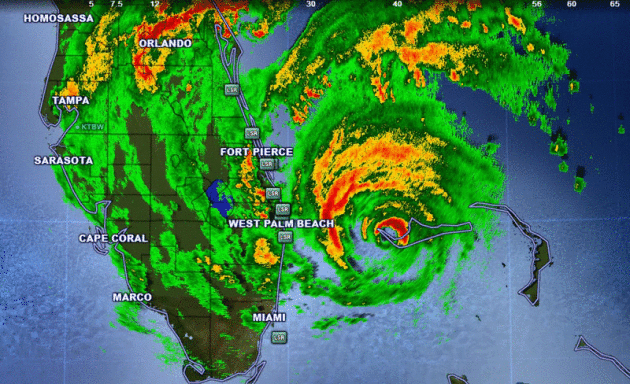71 F. high in St. Cloud Monday.
60 F. average high on October 10.
75 F. high temperature at KSTC on October 10, 2015.
October 11, 1909: A snowstorm hits the state, along with temperatures dropping to 7 degrees over northern MN.

This Year, When In Doubt, Just Predict Rain
"It is curious - curious that physical courage should be so common in the world, and moral courage so rare" said Mark Twain. Tomorrow, at the University of Minnesota I have the honor of introducing one of my personal heroes, Rep. Bob Inglis. A member of the GOP, Inglis was voted out of South Carolina's 4th Congressional district for acknowledging the obvious: the climate is changing - and this time around it's probably not a "natural cycle". He's speaking on how free enterprise can solve climate change as part of the Kuehnast Lecture Series at the Department of Soil, Water and Climate. Details here.
After a stunning Columbus Day reality creeps back in today as clouds stream in; a few light showers tonight and Wednesday morning. That said, this will be one of the drier weeks in what has been a very wet year.
A light frost can't be ruled out Thursday morning before the next sloppy front drags more ill-timed showers into Minnesota Saturday. Sunday looks like the nicer day of the weekend to rake leaves or walk around the lake. Rain returns Monday & Tuesday, but nothing severe.
2016 brought 637 severe storm reports in Minnesota, the most since 2010. Details below.

Twitter photo credit: Lorie Moore.

Hurricane Matthew: Trail of Devastation; 28 Dead Across 5 Southern States. Here's an update via ABC News.
Photo credit: "
24th Annual Kuehnast Lecture at University of Minnesota on Wednesday.
I'm looking forward to introducing one of my heroes, Rep. Bob Inglis
from South Carolina, who is leading the effort to find a conservative
solution to climate change. Here's an excerpt from Dr. Mark Seeley at WeatherTalk: "...The 24th Annual Kuehnast Endowment Lecture
will take place on Wednesday, October 12th at 2pm in the University of
Minnesota St Paul Campus Student Center Theater. Our topic this year is
“Climate Change and the American Free Enterprise System.” Our speakers
are Paul Douglas, former Twin Cities broadcast meteorologist and
President of Aeris Weather; and Bob Inglis, former South Carolina
Republican Congressman and founder of RepublicEn.org, which is centered
on conservative principles and a free-enterprise solution to climate
change. This program is free and open to the public."
* More details on the Kuehnast Lecture Series and how you can participate here.
Frac Sand: Winona County Board Poised to Vote After Years of Conflict. The Lacrosse Tribune reports: "...The
planning commission proposal does not call for a ban on industrial sand
production in the county. Instead, it limits the number of industrial
sand mines allowed to operate in the county to six at any one time and
limits the extent of each mine to 40 acres or less. The proposed
ordinance would subject industrial sand mines to additional
environmental and operational regulations..."
Photo credit: Lee Newspapers file photo. "The
Winona County Board will hold a public hearing Thursday on proposed
regulations of frac mining in the county, including the possibility of
an outright ban."
Photo credit: "Civil War-era cannonballs were discovered on a South Carolina shore on Sunday." (AP)
The Definitive Map of America's Creepy Clown Epidemic. Where else but Atlas Obscura? "...And
with that, clown hysteria began. Next came clown sightings in nearby
North Carolina. And, then, sightings—and, increasingly, social media
threats—up and down the Eastern Seaboard. By mid-September, the
sightings and threats had moved west, to Middle America. And by late
September and early October, they'd reached the West Coast. Few of the
threats have amounted to much more than a scare, and even fewer have
produced actual clowns. But in at least a handful of cases, living,
breathing clowns have turned up..."
Map credit: "The
interactive map above tracks over 100 clown sightings and threats
across America, beginning in early August. This map will be updated as
more clown activity happens."

TODAY: Clouds increase, late shower. Winds: SW 7-12. High: 68
TUESDAY NIGHT: Light showers likely. Low: 46
WEDNESDAY: AM showers, then partial clearing and cooler. Winds: NW 10-15. High: 52
THURSDAY: Frosty start? Brilliant sunshine. Winds: S 8-13. Wake-up: 35. High: 57
FRIDAY: Partly sunny, milder breeze arrives. Winds: S 10-20. Wake-up: 42. High: 64
SATURDAY: Chance of rain increases, fairly soggy. Winds: NW 10-15. Wake-up: 51. High: 62
SUNDAY: Brighter, drier day of the weekend. Winds: SE 8-13. Wake-up: 47. High: 66
MONDAY: Ugh. More rain - rumble of thunder? Winds: SW 10-15. Wake-up: 56. High: 67
WEDNESDAY: AM showers, then partial clearing and cooler. Winds: NW 10-15. High: 52
THURSDAY: Frosty start? Brilliant sunshine. Winds: S 8-13. Wake-up: 35. High: 57
FRIDAY: Partly sunny, milder breeze arrives. Winds: S 10-20. Wake-up: 42. High: 64
SATURDAY: Chance of rain increases, fairly soggy. Winds: NW 10-15. Wake-up: 51. High: 62
SUNDAY: Brighter, drier day of the weekend. Winds: SE 8-13. Wake-up: 47. High: 66
MONDAY: Ugh. More rain - rumble of thunder? Winds: SW 10-15. Wake-up: 56. High: 67
Climate Stories....
"Caring for Creation" Makes The Christian Case for Climate Action. Here's an excerpt of a review at The Guardian: "...Recently a book has been published by a faith-science duo. That duo is Paul Douglas, respected meteorologist, entrepreneur, Republican, and Christian, and his writing partner Mitch Hescox who leads the Evangelical Environmental Network (the largest evangelical group devoted to creation care). Their book, entitled Caring for Creation, provides a masterful balance of science, faith, and personal journey. The style of the book is one I have not seen before. It is a side-by-side presentation of first science, then faith, then science, and back to faith. Interspersed within the main text are enlightening anecdotes mainly from weather forecasters across the country which show an informed lived experience of experts watching the climate change before their very eyes. Importantly the authors provide a list of concrete things that we all can do, starting right now to make a meaningful impact in reducing global warming..."
Climate Change Blamed for Half of Increased Forest Fire Danger. The New York Times reports: "Forest fires are burning longer and stronger across the western United States,
lighting up the landscape with alarming frequency. Residents are forced
to flee, homes are incinerated, wildlife habitats are destroyed, lives
are lost. Last year, the Forest Service spent more than half its annual budget fighting fires. Scientists have long theorized that climate change
has contributed to the longer fire seasons, the growing number and
destructiveness of fires and the increasing area of land consumed,
though some experts suggest that the current fire phenomenon is not just
a result of a changing climate, but also fire suppressing policies
practiced by the government for the last century or more..."
Photo credit: "The Loma Fire rages on the Santa Cruz Mountains summit beyond the Giant Dipper Roller Coaster in Santa Cruz." Credit Shmuel Thaler/The Santa Cruz Sentinel, via Associated Press.

Katharine Hayhoe, a Climate Explainer Who Stays Above the Storm. Here's an excerpt from The New York Times: "...Katharine Hayhoe is a national treasure,” said Anthony Leiserowitz, the director of the Yale Program on Climate Change Communication.
He said that she combined powerful communications skills, world-class
scientific credentials and an ability to relate to conservative
religious communities that can be skeptical about the risks of a
changing climate. Gavin Schmidt,
a NASA climate scientist, said in an email that Dr. Hayhoe’s faith is
an important factor, because “people can accept unwelcome truths much
more readily if they come from within, rather than from outside, their
community/family/group...”
Photo credit: Shutterstock.
A Military View on Climate Change: It's Eroding Our National Security and We Should Prepare for It. A friend of mine, fellow Penn Stater Admiral David Titley (retired) has the story for The Center for Climate and Security; here's the intro: "In this presidential election year we have heard much about some issues, such as immigration and trade, and less about others. For example, climate change was discussed for an estimated 82 seconds in the first presidential debate last week, and for just 37 minutes in all presidential and vice presidential debates since the year 2000. Many observers think climate change deserves more attention. They might be surprised to learn that U.S. military leaders and defense planners agree. The armed forces have been studying climate change for years from a perspective that rarely is mentioned in the news: as a national security threat. And they agree that it poses serious risks..."
No comments:
Post a Comment